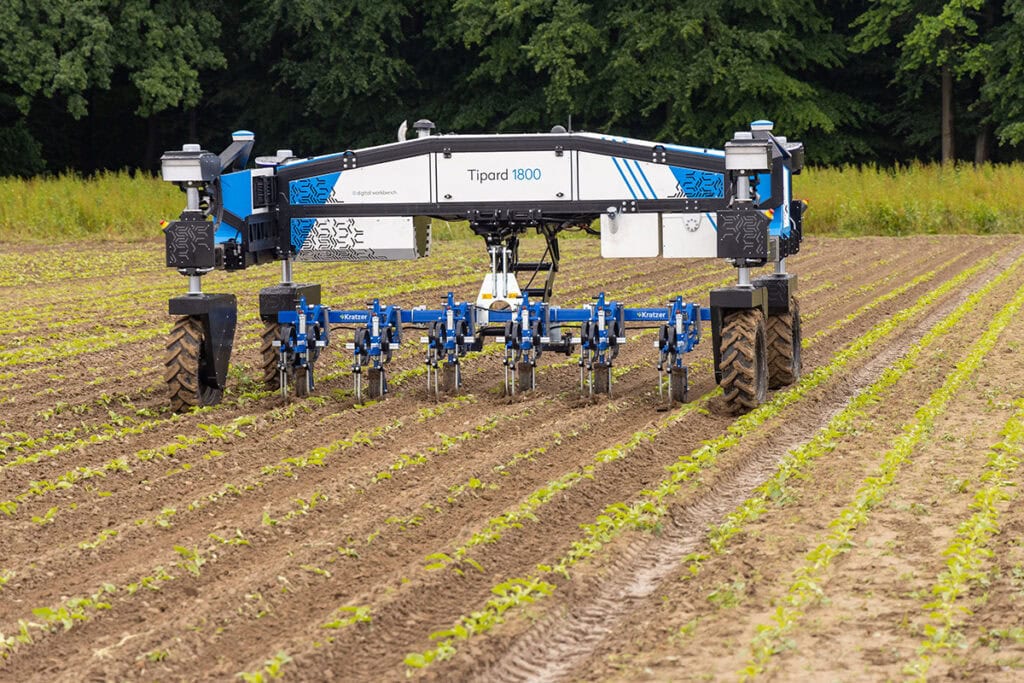PHOTO | Robots as the Focus of the FarmRobotix Program at DLG Feldtage

During the DLG Feldtage in Erwitte, Germany, the organization paid serious attention to robots for the first time. A new part of the fair, the FarmRobotix program, is focused on practical robot and precision farming solutions for both organic and conventional arable farming.
The outdoor event, DLG Feldtage, with numerous demonstrations on 55 hectares of the 290-hectare arable farm Gut Brockhof, attracted 17,000 visitors from 45 countries. The visitors were welcomed by 370 exhibitors from 18 countries. Some of these exhibitors are now part of the new FarmRobotix program. Until this year’s edition in June, the ‘Field Robot Event,’ featuring miniature robots from student teams, was the main aspect of DLG Feldtage related to autonomy and robotics. It is now part of FarmRobotix.
Read also: Hoes and more at the DLG Feldtage

A first in terms of a field demonstration is this Tipard 1800 modular tool carrier from the South German company Digital Workbench. The track width is adjustable, and the vehicle has automatic level control. The hoeing bar is also from South Germany, specifically from Kratzer. The company made this hoeing bar suitable for the Tipard 1800.

Successful in Germany and a few other European countries, this is the Farming GT hoeing robot from Farming Revolution. Farming Revolution originated from Bosch and previously also from Amazone. In fact, this is the (final) result of the Amazone BoniRob, which was first seen at Agritechnica in 2009 (!). There are already 22 units of the Farming GT in operation.

Naturally, AgXeed was also part of the demonstrations. They featured an AgBot with wide tracks and an Amazone Cenius cultivator with AutoTill. Additionally, they showcased this four-wheeled AgBot with the Ecorobotix Ara spotsprayer, which is popular in Germany and the Netherlands.

In the center of this photo is the large VTE field robot/autonomous tractor from Combined Powers, the autonomy-focused collaboration between Krone and Lemken. During the demonstration, the VTE pulled a Karat 10 cultivator. In the bottom right of the image is the specially developed drawbar that allows you to transport the VTE on the road behind a tractor as a trailer.

There is no shortage of AI-supported smart hoes these days. The InRowING from the Austrian company Farm-ING uses artificial intelligence (AI) to recognize plants and hoe around them. It can handle 3 to 11 rows in crops such as sugar beets, lettuce, cabbage, onions, pumpkins, and celery. This year, a limited production series of 15 units was built and sold in Central Europe, with prices starting at €65,000.

The Berlin startup Escarda Technologies is one of the companies combating weeds with lasers. Escarda, which means “weeding” in Spanish, opts for diode lasers which, according to the founder, are more efficient than CO2 lasers. The company developed, at the request of the largest tomato grower in the United States, a version with 10 lasers for 5 rows of tomato plants. This currently costs between €850,000 and €900,000. Escarda is working on CE certification for use in Europe.

Also for weed control, but through spot spraying based on a task map created by this drone, is what SAM Dimension from Germany does. It’s especially aimed at large plots where this drone can map 60 to 80 hectares per hour while flying at a height of 60 meters, using an RGB camera developed by SAM mounted underneath. SAM charges between €10 to €35 per hectare for this service.
Join 17,000+ subscribers
Subscribe to our newsletter to stay updated about all the need-to-know content in the agricultural sector, two times a week.



